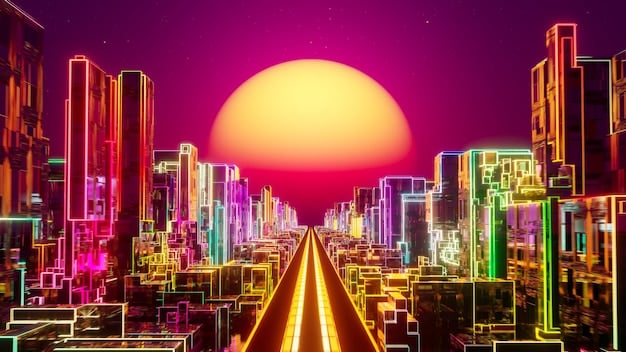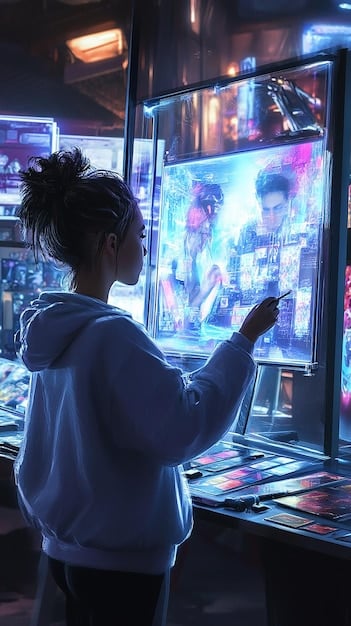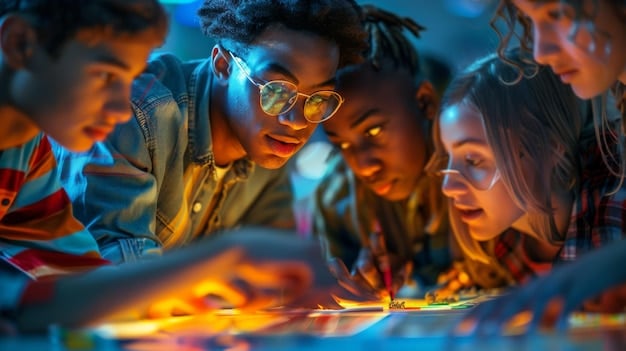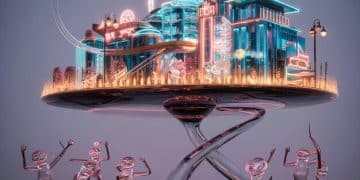Top 5 Pop Culture Predictions for Late 2025

The second half of 2025 is poised to reshape the entertainment landscape, with anticipated shifts in streaming, groundbreaking AI integration in content creation, the resurgence of interactive experiences, evolving fan engagement dynamics, and the continued blurring of real and virtual celebrity, driven by technological advancements and shifting audience preferences.
As we navigate the ever-evolving currents of media and entertainment, the landscape of pop culture remains a dynamic and often unpredictable realm. From the silver screen to social feeds, trends emerge, fade, and sometimes, surprisingly, resurface. Understanding these shifts requires not just observation, but a keen eye for underlying currents and a willingness to look beyond the obvious. For that reason, delving into The Top 5 Pop Culture Predictions for the Second Half of 2025 offers a fascinating glimpse into what promises to be a transformative period. We will explore the forces at play, examining how technological innovation, audience behavior, and creative ingenuity are set to converge, shaping the narratives and experiences that will define our cultural conversation.
The Streaming Wars Evolve: Niche Dominance and Hybrid Models
The relentless “streaming wars” have long been a hot topic, but the second half of 2025 is expected to see a significant evolution beyond pure subscriber count competition. The battle is shifting from broad content libraries to a more granular approach, emphasizing niche dominance and the widespread adoption of hybrid subscription models. Consumers, fatigued by ever-increasing subscription costs, are demanding more tailored experiences and greater flexibility.
This period will likely witness a consolidation of major players, not through outright acquisitions but through strategic partnerships and content sharing agreements. Smaller, specialized platforms dedicated to genres like horror, indie films, specific documentary series, or even interactive narrative experiences, are set to carve out significant market shares. Their success will stem from hyper-targeted content acquisition and a deep understanding of their specific audience’s desires, fostering strong community engagement that larger, more generalized platforms often struggle to replicate.
The Rise of Niche Platforms and Bundling
The market is maturing, and general entertainment behemoths are finding it harder to be everything to everyone. The convenience of a single, all-encompassing platform is being outweighed by the desire for specific, curated content. This shift is giving rise to a new wave of specialized streaming services.
- 📈 **Hyper-Focused Content Libraries:** Platforms dedicated to specific genres (e.g., retro gaming, classic anime, independent cinema) will thrive by offering unparalleled depth in their chosen vertical.
- 🤝 **Strategic Bundling Initiatives:** Major players will increasingly partner with these niche services or even with competitors to offer attractive, discounted bundles, mimicking traditional cable packages but with greater user control.
- 🌍 **Localized Content Prioritization:** Investment in high-quality, culturally relevant localized content will become a key differentiator, appealing to regional audiences and fostering deeper engagement.
Furthermore, expect to see more innovative hybrid models. Ad-supported tiers will become standard across almost all platforms, moving beyond simply being a cheaper alternative to becoming a viable, profitable segment. Premium VOD (Video On Demand) windows for new releases will also see a resurgence, allowing studios to monetize high-demand content outside traditional subscription cycles. The future of streaming isn’t just about what content is available, but how economically and conveniently consumers can access precisely what they want.
AI Integration in Creative Content Production
Artificial Intelligence (AI) has been a buzzword across industries, but in the latter half of 2025, its integration into pop culture content creation will move beyond novelty into foundational processes. From scriptwriting assistance to character design and even entire animation sequences, AI tools will become integral to the creative pipeline, significantly impacting both efficiency and artistic output. This isn’t about AI replacing human creativity, but augmenting it.
Imagine screenwriters utilizing AI to generate nuanced character dialogues, directors pre-visualizing complex scenes with unprecedented detail, or animators leveraging generative AI to rapidly produce background elements or even full secondary characters. The promise is faster production cycles, reduced costs, and the ability to experiment with concepts that were previously too time-consuming or expensive. However, this also raises critical questions about intellectual property, authorship, and the unique spark of human artistic vision.

Ethical Frameworks and Copyright Challenges
As AI becomes more sophisticated in replicating and even generating creative styles, the legal and ethical landscape surrounding its use will be a major point of contention. The industry will grapple with establishing clear guidelines and copyright frameworks.
- ⚖️ **IP and Ownership Debates:** Who owns content generated by AI, especially when it’s trained on existing copyrighted material? This will lead to landmark legal battles and industry-wide policy discussions.
- 🛠️ **Tool-Agnostic Creativity:** Artists will increasingly be defined not just by their innate talent, but by their ability to master and ethically wield advanced AI tools to bring their visions to life.
- 🎨 **The Authenticity Question:** Audiences and critics will debate the “soul” of AI-generated art, pushing creators to find new ways to imbue their work with unique human perspectives, even with AI assistance.
The entertainment industry will likely form new consortiums and task forces to establish best practices for AI use, balancing innovation with the protection of human artists’ rights. This period will be crucial in defining the collaborative future of human and artificial intelligence in shaping the stories we consume.
Interactive Storytelling and Gamified Experiences Go Mainstream
The line between traditional media consumption and interactive experiences has been blurring for years, but the second half of 2025 will see interactive storytelling and gamified elements become a mainstream expectation, not just a niche novelty. This extends beyond simple “choose-your-own-adventure” shows to truly immersive and personalized narratives.
Audiences are seeking agency. They want to be active participants in the stories they engage with, not just passive observers. This trend will manifest across various forms of media, from streaming platforms incorporating deeper branching narratives and user-driven plot points, to live events integrating real-time audience participation that influences outcomes. Technologies like enhanced virtual reality (VR) and augmented reality (AR) will play a pivotal role, offering unparalleled levels of immersion.
Beyond the Screen: Experiential Entertainment
The push for interactivity isn’t limited to digital platforms. Real-world experiences are also embracing gamification to enhance engagement and provide unique, memorable encounters.
- 🎭 **Live Immersive Productions:** The theater and live performance industry will increasingly adopt interactive elements, putting audiences at the center of the narrative, reminiscent of sophisticated escape rooms and interactive art installations.
- 📱 **AR Layered Realities:** Everyday environments will become canvases for augmented reality experiences, turning city streets into interactive game boards or historical sites into living museums via mobile devices.
- 🌐 **Transmedia Narrative Universes:** Franchises will launch content where plots unfold across films, video games, social media, and even real-world events, with audience participation dictating the direction of the overarching story.
The success of these interactive initiatives will hinge on seamless technology, intuitive user interfaces, and compelling narratives that genuinely benefit from audience input. Creators will face the challenge of balancing structured storytelling with the unpredictable nature of participant choices, leading to innovative narrative design and dynamic content creation workflows.
The Evolution of Fan Engagement: Co-Creation and Decentralization
Fans have always been passionate, but their role is rapidly transforming from passive consumers to active participants, and even co-creators. The second half of 2025 will see this evolution accelerate, driven by technologies like blockchain and new social media paradigms that foster decentralized communities and enable genuine collaboration between creators and their most ardent supporters.
Forget simply following and commenting; fans will have more direct avenues to influence storylines, fund projects, and even own digital assets related to their favorite franchises. Platforms built on Web3 principles could enable token-gated communities where membership grants voting rights on creative decisions, access to exclusive content, or even a share of future profits. This shift democratizes parts of the creative process, empowering fans in unprecedented ways.
Community-Driven Content and Ownership
The traditional top-down model of content creation is being challenged by a grassroots movement of fan-driven initiatives, which are gaining momentum through innovative digital tools.
- 🎨 **Fan-Art to Canon:** More major studios and creators will officially incorporate standout fan creations (e.g., character designs, lore expansions, alternative storylines) into established franchises, blurring the lines between amateur and professional.
- 🗳️ **Decentralized Project Governance:** Blockchain-enabled DAOs (Decentralized Autonomous Organizations) could emerge for specific IPs, allowing token holders (fans) to vote on aspects like merchandise design, spin-off concepts, or even casting choices.
- 🎁 **Earned Digital Collectibles:** Beyond static NFTs, dynamic digital collectibles that evolve based on fan interaction or significant in-universe events will offer new avenues for engagement and digital ownership.
This increased fan participation also brings challenges, including managing diverse opinions, maintaining creative integrity, and navigating the complexities of decentralized ownership. However, for creators willing to embrace this collaborative spirit, the potential for deeper engagement and building truly loyal, invested communities is immense. It signals a future where content is not just consumed, but collectively owned and shaped.

The Blurring Lines: AI-Generated Influencers and Virtual Celebrities
The rise of virtual influencers and celebrities has been a fascinating subplot in pop culture, but by the second half of 2025, their presence will be undeniable and multifaceted, significantly blurring the lines between human and synthetic fame. Advancements in AI, photorealistic rendering, and natural language processing will make these digital entities virtually indistinguishable from their human counterparts, at least on a superficial level.
These virtual personalities, unburdened by human limitations or controversies (though not immune to programming glitches or ethical debates), offer unique advantages for brands and content creators. They can be available 24/7, perfectly control their image, and adapt instantly to trends. This proliferation will raise profound questions about authenticity, parasocial relationships, and the very definition of “celebrity.”
Impact on Marketing and Social Dynamics
The growing influence of virtual celebrities is poised to reshape brand endorsements, social media trends, and even our psychological relationships with public figures.
- 🛍️ **Hyper-Targeted Brand Endorsements:** Virtual influencers can be meticulously crafted to embody specific demographics or aesthetics, offering brands unprecedented precision in their marketing campaigns.
- 🗣️ **AI-Powered Personalities:** Beyond static images, advanced AI models will allow these virtual beings to engage in real-time, nuanced conversations, blurring the line further between interacting with a person and an algorithm.
- 🎭 **Ethical Considerations:** Discussions around disclosure (is it clear this is not a human?), potential for manipulation, and the impact on mental health (especially for younger audiences) will intensify.
The market will likely stratify, with a clear distinction between human ‘authentic’ influencers and ‘curated’ virtual ones. However, the sheer volume and sophistication of AI-generated content will challenge audiences to discern reality, forcing a reevaluation of what makes a connection “real” in the digital age. This prediction suggests a future where fame can truly be manufactured, raising new opportunities and ethical dilemmas for the cultural landscape.
Pop Culture and Societal Intersections: A Converging Future
Pop culture is rarely just entertainment; it’s a mirror reflecting societal shifts and, often, a catalyst for them. In the second half of 2025, the relationship between pop culture and broader societal trends will become even more intertwined, with entertainment playing a crucial role in shaping public discourse around critical issues. As global challenges persist and new technologies emerge, cultural narratives will increasingly address themes of sustainability, digital ethics, and evolving social identities.
Beyond direct messaging, expect subtle yet pervasive shifts in storytelling that normalize diverse perspectives, explore complex moral dilemmas, and engage audiences with topics that might otherwise feel abstract. From the rise of climate-fiction (Cli-Fi) to narratives that delve into the implications of AI on humanity, pop culture will serve as a vital conversational ground. This means more creators will consciously weave in socially relevant themes, driven by both artistic intent and a recognition of audience demand for meaningful content.
Cultural Commentary and Storytelling
The power of storytelling to reflect and influence societal values will be leveraged more deliberately within popular media. This goes beyond overt political statements to more nuanced explorations of human experience within changing global contexts.
- 🌱 **Eco-Conscious Narratives:** Environmental themes will move from background elements to central plot drivers in films, series, and even video games, fostering greater awareness and prompting dialogue on sustainability.
- 🤖 **Ethical AI Dilemmas:** As AI integration expands, narratives will increasingly examine the ethical boundaries of artificial intelligence, prompting viewers to consider the societal implications and human impact of these technologies.
- 🏳️🌈 **Evolving Identity Explorations:** Pop culture will continue to broaden its portrayal of diverse identities, pushing boundaries in terms of gender, sexuality, and cultural representation, fostering greater understanding and inclusivity.
The interaction between pop culture and society will become a feedback loop: societal conversations will inspire creators, and their resulting narratives will, in turn, shape public perception and encourage further dialogue. This predictive period highlights a future where entertainment carries increasingly significant cultural weight, moving beyond escapism to become a driving force in collective thought and social evolution.
| Key Prediction | Brief Outlook |
|---|---|
| 🍿 Niche Streaming Dominance | Specialized platforms and content bundles will redefine subscription models. |
| 🤖 AI in Content Creation | AI tools will become integral to scriptwriting, animation, and production efficiency. |
| 🎮 Mainstream Interactive Narratives | Audiences will actively participate in stories via streaming, VR, and live events. |
| 🌟 Virtual Celebs & Influencers | AI-generated personalities will blur lines of fame and influence marketing. |
Frequently Asked Questions About Pop Culture in 2025
No, traditional cinema is unlikely to disappear. Instead, it will likely evolve to offer more unique, event-based experiences. The second half of 2025 will see arcades focusing on premium formats, interactive elements, and communal events that streaming cannot replicate, rather than competing solely on content availability.
AI’s impact on employment in entertainment is a complex issue. While some repetitive tasks might be automated, AI is also expected to create new roles, particularly in AI supervision, ethical guideline development, prompt engineering, and managing AI-human collaborative workflows. Human creativity will remain indispensable, shifting focus to conceptualization.
Virtual influencers pose a new form of competition but are not an existential threat to human celebrities. They fill different niches. Virtual influencers excel in brand control and 24/7 availability, while human celebrities offer authenticity, genuine emotional connection, and relatable personal experiences that AI cannot fully replicate.
While audience co-creation introduces an element of unpredictability, it’s unlikely to lead to chaotic storylines uniformly. Content creators will develop sophisticated frameworks and narrative guardrails to manage fan input, ensuring coherence while still empowering participation. It will push innovation in narrative design, not necessarily chaos.
Diverse representation in pop culture will continue to be critically important and increasingly expected by audiences in late 2025. Authenticity and inclusivity across various demographics, identities, and experiences will be key drivers of audience engagement and critical acclaim, reflecting a global shift in societal values and media consumption.
Conclusion
The latter half of 2025 is shaping up to be a pivotal period for pop culture, marked by profound shifts in how content is created, distributed, and consumed. From the strategic repositioning of streaming services to the burgeoning influence of AI in creative processes, the industry is poised for transformative change. Interactive storytelling will foster deeper audience engagement, while the lines between human and artificial celebrity continue to blur, challenging our perceptions of fame and authenticity. These predictions suggest a vibrant, sometimes disorienting, but ultimately exciting future where technology, creativity, and evolving societal values converge to redefine our cultural landscape.





